

 This blog was written by Harriet Peabody, Research Analyst at Anova.
This blog was written by Harriet Peabody, Research Analyst at Anova.
A successful win / loss program offers a wealth of benefits for businesses by providing valuable insights into customer behavior and overall sales effectiveness and can help businesses to continuously improve in order to stay competitive. However, if a win / loss program is not executed or utilized correctly, this limits the advantages one can gain from it. Whether you are using a home-grown win / loss solution or running the program through a third party, there are certain best practices which will help you take full advantage of the benefits win / loss can offer.
In our experience here at Anova, one of the biggest hindrances to program success is at the deal-flow level. The most important thing for program success is having sample to work with. There are two ways companies run into problems here:
Relying solely on CRM data can make it difficult to reach the contacts you are targeting, as this data is often inaccurate. You need to ensure you are reaching the right contact who will have the best insight into the sales process, and that the contact information you are using is correct.
This issue has to do less with logistics and more with company culture. Here at Anova, one of our values is a growth mindset, which is fostered by feedback. It is important to learn and grow from feedback, rather than reacting defensively. If salespeople fear negative repercussions from submitting a lost deal for feedback, they will miss out on an important learning opportunity. A company with a culture that is open to feedback will encourage salespeople to learn from their losses without fear of ramifications.
In putting the process into place for win / loss, ensure that representative deals are chosen for feedback, including a split of both wins and losses, and that the interviews occur shortly after the sales process to get the most relevant and accurate data. In our experience, a phone interview has the best results, both for the quality of data collected and the response rate, as opposed to an online survey. Tailor your interview guide according to your business and what you are looking to learn.
When it comes to the analysis and insights phase of the program, if you are running a home-grown solution, you will need to take on the data analysis and present the results in an effective way. Use the interview data to identify trends and recurring themes. Look for common reasons for wins and losses, competitor strengths and weaknesses, and areas for improvement in your sales process or product offering. Equally important to the insights gleaned from the data is what you do with them. For best results, present the findings in a clear and concise way in order to help stakeholders easily understand the key takeaways.
Throughout your program, internal or external, ensure the interviews are distributed to the stakeholders who will be able to learn and take action from them – and the same goes for the program end results. Not only should you distribute the findings liberally in your organization, but you must also develop concrete action plans based on the insights. This could involve sales training, product enhancements, or adjustments to marketing messaging.
Whether run internally or with a third party, there are aspects of all steps of the win / loss process which are under your control and will improve program success for your company. In keeping with a growth mindset, a win / loss program is something that should be sustained year over year. If you are striving for continuous improvement, you can never rest on your laurels, and should be seeking feedback and looking for new ways to grow indefinitely. The most successful programs are years in the making, giving you years of historical data to analyze for trends and track your improvement in various areas. This will hold your company accountable for learning from feedback and acting on the insights uncovered by your win / loss program.
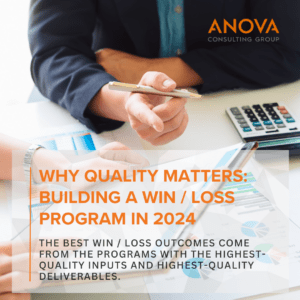 This blog was written by Andrew Cloutier, Partner at Anova.
This blog was written by Andrew Cloutier, Partner at Anova.
If It Sounds Too Good to Be True, It Probably Is. In general, teams are being asked to do more with less, both in terms of budget and FTEs. As such, the automation of processes is an important consideration in terms of cost and time savings.
The rise of automation and generative AI has created exciting opportunities across industries, including win / loss. While the potential of AI is undeniable, it’s important to approach it with a realistic mindset. An advanced AI model, no matter how sophisticated, cannot compensate for flawed data sources or poorly designed processes.
Practitioners of win / loss need to have a point of view and plan for taking advantage of automation and AI-driven opportunities, both for operational efficiency and insight generation purposes. But it is also important not to engage in “magical thinking” as it relates to the fundamental blocking and tackling of gathering and analyzing win / loss data. The most advanced generative AI model in the world is useless if its data source is faulty, and a fully automated survey process isn’t particularly helpful if the survey isn’t getting sent to the right people or generating meaningful responses. In short, if it sounds too good to be true, it probably is.
Qual Matters – High-Quality, Qualitative Feedback from Qualified Respondents
The best win / loss outcomes come from the programs with the highest-quality inputs and highest-quality deliverables.
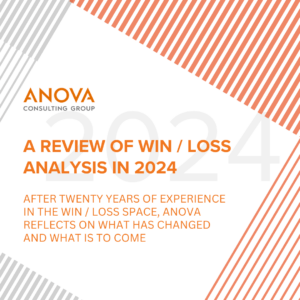 This blog was written by Andrew Cloutier, Partner at Anova.
This blog was written by Andrew Cloutier, Partner at Anova.
As Anova celebrates its twentieth birthday this year, we reflect on the evolution of win / loss analysis—a vital tool for understanding buyer behavior and improving sales strategies. Though much about win / loss analysis has remained consistent over Anova’s tenure, many things have also changed, and the pace of change has accelerated over the last few eventful years. Understanding these changes can make the difference in empowering businesses to stay ahead in competitive markets.
This blog series explores the significant changes we’ve seen over the past decade, the enduring principles, and practical tips on how organizations can run an effective win / loss program in 2024.
What Has Changed in Win / Loss Over the Last Decade
While Anova continues to embrace opportunities to educate sales and marketing executives about the value of win / loss analysis, awareness and adoption of win / loss analysis has dramatically increased across industry verticals. Conversations that used to be about why the voice of the buyer is so valuable have transformed into conversations about how organizations can get the most out of voice of the buyer programs.
Today, organizations have access to a much broader range of win / loss solutions—from homegrown programs to automated surveys and hybrid, custom approaches. It is important for buyers to understand the benefits and drawbacks of various options to ensure they pursue the type of program that will provide the most value to their organization.
A notable shift has been the transition of program ownership from sales leaders to product marketing and/or competitive intelligence teams. Though each of these constituencies are consumers of win / loss insights, maintaining connectivity with sales remains essential for program success. Trust and transparency in the process as well as a free flow of timely win / loss contact information are critical components.
Across industry verticals, Anova has found that the lengthening of sales cycle times and the increasing difficulty for B2B buyers to make buying decisions can be attributed to the following factors:
What Has Stayed the Same in Win / Loss Over the Last Decade
While the macroeconomic climate changes, win / loss remains a critical tool in both bullish and bearish market conditions. When budgets are tight and deal flow is down, each sales opportunity increases in importance, and having an in-depth understanding of buyer perceptions can provide the edge that makes the difference between a loss and a win. Conversely, when budgets are free-flowing and sales are booming, win / loss analysis can provide a key source of best practices and sales training materials for expanding teams. It also serves as a rich source of up-to-date competitive intelligence for both established competitors and new market entrants.
The computing adage “garbage in, garbage out” continues to apply to win / loss analysis. In a win / loss program, a primary source of program inputs is CRM data. Incomplete or inaccurate CRM data is a shaky foundation for an insightful win / loss program. This challenge becomes magnified in solutions that prioritize automation without including proper checks and balances to ensure data quality.
An effective win / loss program is not just a tool for understanding past sales outcomes but a strategic asset that can drive future success. Through the pursuit of continuous improvement, organizations can unlock valuable insights that lead to improved decision-making, competitive advantage, and sustainable growth.
 This blog was written by Zach Golden, Director of Client Management at Anova.
This blog was written by Zach Golden, Director of Client Management at Anova.
“The single biggest challenge of selling today is not selling, it is actually our customers’ struggle to buy.”
That quote from Gartner probably sums up a lot of what B2B sales teams are currently feeling.
Sales leaders that Anova talks to are constantly scratching their heads over an increasingly frustrating phenomenon: the no decision.
Why is that? What is causing more sales processes to stall? The list is long, but a few key factors are:
For an individual seller though, all those factors are out of their control.
Still, the first thing a seller needs to recognize is the importance of accountability. As the old saying goes: it isn’t about the cards you’re dealt, but how you play the hand.
A seller can’t make the buyer more experienced in their role, but they can help the buyer be more confident in moving forward by clearly outlining what the risks of not making a decision are.
A seller can’t tell a buyer to limit the number of people in their buying committee, but they can build trust through impressive business acumen and understanding of the buyer’s company / business problems so that the buyer doesn’t feel like they need to bring in other perspectives as well.
A seller can’t tell a buyer not to evaluate their competition, but they can differentiate effectively and share social proof of customers who have switched over to their product from competitors a buyer may be interested in.
There is always something in the seller’s control they can do to guide and empower a buyer to feel confident in making a decision. Ultimately, building confidence and de-risking a buyer’s decision are key factors in overcoming the dreaded “status quo” that so many deals are being lost to.
 This blog was written by Zach Golden, Director of Client Management at Anova.
This blog was written by Zach Golden, Director of Client Management at Anova.
At the foundation of any win / loss program is the raw input: deals.
When deal volume declines, though, it poses critical challenges to the success of any win / loss program. The chief risks are limited analytic capabilities and challenges in trend identification as small sample sizes make it harder to distinguish between actual trends and random occurrences.
However, for companies who still want to commit to the values of having an ongoing win / loss program, there are ways to maximize the value of feedback, even if the number of deals in your pipeline seems to be on a more limited scale:
Limited deal flow doesn’t mean a company can’t achieve the value of win / loss. If anything, it means any feedback you get is likely going to be more representative of your overall pipeline. Keeping that in mind, focusing on qualitative findings, and searching for other opportunities for feedback can help businesses still achieve positive impacts from their program.
 This blog was written by Zach Golden, Director of Client Management at Anova.
This blog was written by Zach Golden, Director of Client Management at Anova.
In a recent Spotio study on B2B buying decisions in 2023, a staggering revelation emerged: “B2B buyers are 57%-70% through buying research before contacting sales”.
This statistic underscores the significant impact of pre-existing biases that most inbound prospects carry when engaging with sales teams. These biases encompass perceptions about your product, your company, competitor offerings, and ultimately which solution they will likely end up choosing.
On the one hand, this can work to a sales teams’ advantage if the prospect has determined their solution to be the early favorite. But even still, there appears to be much out of a salesperson’s control in B2B sales.
So, what can a salesperson do to overcome this and gain back control of the process?
One effective strategy is for salespeople to position themselves as consultants, dedicated to helping prospects understand and address their challenges.
Understanding the Consultative Approach
Anova defines a consultative approach (in the context of B2B sales) as being able to effectively align a solution to meet the needs of a prospect. It is an advanced sales skill, requiring nearly every tool in the sales toolbox, including:
Being consultative goes beyond making recommendations; it involves actively solving the customer’s problems. When done well, this approach can reframe a prospect’s understanding of their own challenges.
Why is a Consultative Approach Important?
Due to the increasing independence of customers in researching solutions, prospects often believe they fully understand their problems. However, a consultative approach can play a pivotal role in reframing the problem and demonstrating how a solution can genuinely address the challenge at hand.
Anova’s data underscores the importance of helping customers better understand their challenges as a key factor in winning B2B sales engagements. In fact, of all the sales metrics Anova tracks across win / loss studies, an effective consultative approach has the highest correlation with winning a B2B sales engagement, more so than product demo quality, ability to make the prospect feel important, and differentiation.
While implementing a consultative approach can be challenging, its impact can be measured and refined through win/loss interviews. These interviews provide valuable feedback from individual prospects, allowing sales teams to continually enhance their consultative approach and gauge its effectiveness over time.
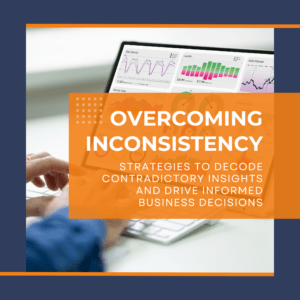 This blog was written by Zach Golden, Director of Client Management at Anova.
This blog was written by Zach Golden, Director of Client Management at Anova.
Stop me if you’ve experienced this before: you’re looking at data to help inform a business decision, but the data seems contradictory.
Perhaps it should be stop me if you haven’t experienced this, because it’s likely you have. Collect enough data points about anything and it’s likely you will find at least two that contradict one another.
Win / loss data is no different. It’s common that companies with win / loss programs have to pause to scratch their head when they start to review findings:
Our solution’s ease of use is being cited as both a strength and a weakness?
Our sales performance is a factor when we win but also when we lose?
Our pricing is competitive but also a reason why we are losing?
At Anova we see these seeming contradictions, what we typically call inconsistencies, every day because of our position as a win / loss partner to our clients. And while sometimes the data can be a head scratcher, our job is to help our clients understand the subtle nuances that cause this inconsistency.
Here are some of the main reasons why you may be seeing inconsistencies in your own data:
High Level Categorizations
When going through feedback from your win / loss interviews or surveys it’s likely you have to bucket or tag the responses into categories that make sense: sales, product functionality, price, etc.
Relying on these broad categorizations is helpful, both to get broad brush strokes of a theme (e.g., 80% of customers like our product functionality) and understand where different areas of your business lie in the eyes of the market (e.g., 80% of customers like our product functionality, compared to only 20% which like our user experience… The market thinks our product can do everything but is overly complex).
However, because of how broad these categories are, it can be confusing when that same category is seen both positively and negatively (e.g., 80% of customers cited our product as a strength, but 75% said it was a weakness… is our product good or bad?!). Part of this is because the category itself has so many specifics to it. For instance, for one client of ours in the supply chain management space, their product is highly praised for things like supply planning and demand planning, but forecasting and the ability to generate custom reports are commonly cited as weaknesses.
Getting to deeper levels of specificity helps our client understand what exactly the market appreciates, and where they need to continue to work.
Segmentations
Sometimes the specificity of feedback is evident, but not who is saying it. That’s where doing some sleuthing becomes necessary. Segmenting the data allows teams to pinpoint if different populations or personas are providing inconsistent feedback about their experience interacting with your company.
For example, in one recent client program we saw large inconsistencies with ratings of its pricing. While discounting was a common practice, the client still thought it should be in the ballpark for the majority of its deals. When we applied a deal size segmentation we uncovered in large enterprise deals the client was largely seen as competitive, but satisfaction with its pricing was much lower in SMB deals. The reason for this was there were many new entrants targeting the SMB market, and were trying to undercut on price.
Our client used this greater granularity of understanding what segment of the market was providing which type of feedback to roll out an updated pricing model for its starter package, commonly utilized in the SMB market, while maintaining its legacy pricing model in its enterprise business.
Team Performance Level
Perhaps the most head-scratching comes from analyzing sales team’s performance metrics. Sales leaders are looking for definite truths about where their team is strong and weak to know where to prioritize investment and training.
However, looking at average scores for the team’s performance in metrics like product demo quality or differentiation don’t always tell the whole story. It can be common to see something rated highly in wins, but poorly in losses. This is especially true when thinking about how the amount of turnover experienced at so many organizations over the last few years has led to great variances in salesperson tenure and product knowledge. Different team members have different skill levels.
Not only do technical skills, tenure, and knowledge all differ amongst your team members, but consistently in and of itself is a hard skill to master.
This is seen all the time in sports: think of a football team that can beat anybody in the league, but when playing in games they are heavily favored, plays down to the inferior level of their opponent only to lose games they shouldn’t. Or the basketball player who can score 30 points one night and 3 the next. What is commonly said on sports talk shows the next day? The team / player needs to be more consistent.
**
Often there are data-driven reasons for inconsistency in your win / loss findings: maybe the categorizations you are using are too broad and you need to be drilling down to a deeper level of specificity. Maybe the different sentiments are coming from different populations of your customer base. Or maybe your team just hasn’t mastered the skill of being consistent.
It’s hard to know which is the right answer, which is why relying on an expert win / loss consultant can help you make sense of your data. Click here to schedule a consultation with one of Anova’s experts.
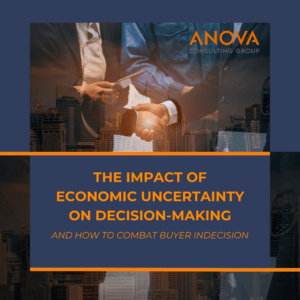 This blog was written by Brian McMahon, Consultant at Anova.
This blog was written by Brian McMahon, Consultant at Anova.
In a year marked by positive economic indicators, including steady stock market gains, a low unemployment rate, and a drop in inflation, one would expect optimism to permeate boardrooms and executive offices. However, a surprising trend emerges: despite these positive signs, a notable pessimism persists among consumers, businesses, and executives regarding the economic outlook. This skepticism is underscored by the findings of the “Measure of CEO Confidence” study, conducted by the Conference Board in late 2023, revealing that 47% of CEOs anticipate a decline in economic conditions over the next six months—a notable increase from 39% in the previous quarter. Moreover, a staggering 72% of CEOs are preparing for a potential U.S. recession within the next 12-18 months.
The Impact of Economic Uncertainty on Decision-Making:
This prevailing economic uncertainty has a profound impact on decision-makers, rendering them more hesitant than ever to make significant purchase decisions. The reluctance to commit is further exacerbated by a fear of purchasing, rooted in what is known as the omission bias—the customer’s desire to avoid taking action that may lead to a loss.
Last year, Matthew Dixon and Ted McKenna of DCM Insights wrote a compelling piece entitled: Stop Losing Sales to Customer Indecision. I would highly recommend it to anyone who is looking to more deeply understand what is driving purchasing decisions (or the lack thereof) nowadays. Anyway, in their research they highlight that customer indecision is responsible for the loss of 40-60% of deals today.
What We’re Seeing Here at Anova:
Anova Consulting Group, having observed these trends across various industries, notes a parallel shift in buyer behavior. To delve deeper into this trend, I took a deeper dive into Anova’s recent work in the retirements and benefits space. What makes the benefits industry an interesting test subject for evaluating indecision is the existence of an already existing solution / provider, combined with the fact that the situations that we examine in this space are those where the sponsor / decision maker made the conscious decision to take this business out to market.
Anova traffics in competitive won and lost situations. So, the deals for which we interview generally entail sales presentations, or long, ongoing, repeated sales conversations. As such, when a plan is brought out to bid, and this process is undergone, most prospects end up moving their plan. However, in 2023, the proportion of plans that are staying with their incumbent provider or putting off / declining to make a decision has seen a sharp increase. In 2021, roughly 20% of losses for our retirement clients made no change in their plan provider, and in 2023, that number YTD is ~37%, almost doubling.
For many of our benefits clients, we ask interviewees how likely they were at the outset of the evaluation to change providers. Generally, when interviewing clients from wins, a considerable portion reflected that they had only been “somewhat likely” to switch at the outset of their evaluation. In other words, they entered somewhat uncertain, but ended up making the decision anyway. We are seeing fewer and fewer of these cases wins that started uncertain but made the decision to switch anyway. In 2021, almost 40% of retirement wins fell into this category and were “somewhat likely” to switch at the outset. In 2023 that number has dropped in half to ~20%, indicating that it is becoming harder and harder to convince executives to make a decision, if their mind was not already made up at the outset.
How to Combat Indecision:
To navigate this environment of heightened buyer indecision, Matthew and Ted prescribed the JOLT method as the strategic approach. The four elements of the JOLT method are:
For us at Anova, the JOLT method, particularly steps 2 and 3, aligns very closely with the recommendations we make to our own clients on how to maximize sales performance. Granted, every sales team is different and will each have different areas of need. However, we have found that a good barometer for identifying a high performing sales team is in how well it succeeds at understanding the unique needs of the customer and proposing a distinct, tailored solution that aligns with those needs. When this is done correctly, the sales team is far more likely to differentiate their offering, sell the value proposition, and win the business.
In 2023, with the heightening indecision that is endemic in the marketplace, demonstrating these skills has become more important than ever.
In their own recent research, Matthew and Ted cited substantial improvements to win rates when sales teams successfully utilized these strategies. They found that when sales teams were able to combine a strong diagnosis of needs with a tailored recommendation that aligns with those needs, win rates rose from 14% to 36%.
Anova’s research is uncovering similar results. Thus far in 2023, we have seen that understanding a client’s unique needs and taking a consultative and prescriptive approach to meeting those needs is vital to winning business. Over the last eight aggregate reports Anova has done across all industries, an average of 93% of respondents in wins rated themselves as “satisfied”* with the ability of the winning sales team to understand their unique needs. For consultative approach, the percentage of satisfied respondents was 89%.
And when you delve specifically into benefits providers, these findings become even clearer. Over the past four reports examining win / loss data for benefits providers, average satisfaction with needs assessment and consultative approach in wins was 96% and 94%, respectively. Furthermore, 41% of respondents in these programs cited the consultative approach taken by their sales team as a key strength, unprompted. For reference, the average percentage of respondents who cited this as a strength across all Anova programs in 2022 was just 23%.
The importance and value of needs assessment and consultative approach is not new. High performing sales teams have always been better in these areas, and proficiency with them has always been correlated to winning. However, due to widespread and increasing buyer indecision, these skills are transforming from “nice-to-haves” to table stakes necessary to win business.
Conclusion:
Executives and buyers are pessimistic about our short-term economic outlook, and it is showing in how they are approaching purchase decisions. Buyer indecision and fear of purchasing is becoming more and more prevalent, and sellers need to revise their approach to combat this. In addition to gauging buyer indecision at the start of the process, sales teams need to accurately assess and display an in-depth understanding of each client’s unique needs during the sale. As economic uncertainty and doubt reign, showcasing that understanding and proposing a distinct and customized solution that takes the burden of choice off the buyer has become vital in overcoming indecision and winning business.
*Note: In Anova methodology, satisfaction is calculated as the percentage of quantitative responses scored 6 or 7 on Anova’s 7-point scale.
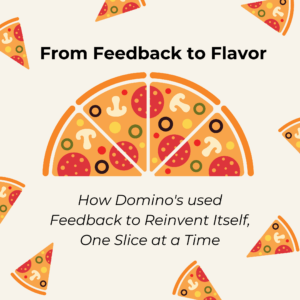 In 2009, Dominos underwent one of the most famous and successful ad campaigns in the 21st century. But it wasn’t just an ad campaign; it was a transformation of their very identity. Dominos looked in the mirror, saw they needed to change, and acted on it. The subsequent years of growth and success were a direct result of this initiative.
In 2009, Dominos underwent one of the most famous and successful ad campaigns in the 21st century. But it wasn’t just an ad campaign; it was a transformation of their very identity. Dominos looked in the mirror, saw they needed to change, and acted on it. The subsequent years of growth and success were a direct result of this initiative.
For those of you who don’t remember, in the years leading up to this change, Dominos was not exactly lauded as a provider of premier cuisine. Dominos was the last resort of last resorts. Kept in business largely by intoxicated college students and desperate insomniacs, Dominos occupied a space in public opinion slightly above uncooked ramen and slightly below a plain, folded-up tortilla. The sauce tasted like ketchup, and the crust tasted like cardboard.
That last sentence was not my own opinion; they are verbatim comments from customers, and those two statements were broadcast across the United States to everyone who would listen. Because instead of burying their heads in the dough, Domino’s did something radical: they admitted they were “sucking.” In what was dubbed as the “We’re Sorry for Sucking” campaign, Dominos found some of the most biting criticism about their product, publicized it, apologized, and promised to act.
This wasn’t your typical PR spin; it was a raw, honest apology. Domino’s aired commercials showcasing their subpar pizzas, invited customers to roast them on social media, and came clean on methods they had been using to make their pizza look more appetizing than it was. It was a gamble, a public flaying, but it was also a masterclass in the power of gathering, and acting on, feedback.
So, what made this campaign so successful? Here are a few key takeaways:
Embrace your flaws: Denial is a recipe for disaster. By acknowledging and accepting its issues, Dominos was able to clearly see what needed to be done and organize a plan of action.
Listen to your customers: They didn’t just hear the complaints; they actively sought them out, creating avenues for customers to voice their frustrations.
Show you’re listening: By showing customers that they were listening to and acting on their feedback, Dominos conveyed that they valued their customers and wanted to meet their needs.
Act on the feedback: Domino’s didn’t just apologize; they used the feedback to overhaul their recipes, improve their service, and invest in technology.
Be transparent and authentic: The campaign wasn’t slick or polished; it was honest and relatable. By being humble and willing to change, Domino’s established trust with its customer base.
The results were nothing short of spectacular. On December 31st, 2009, Domino’s stock price was $6.87. As I am writing this in early 2024, Domino’s stock price is $426.77. That represents an increase of over 6200%. In that same time, Domino’s market share went from 9 – 15%. There are a lot of factors that drive financial performance, so this growth cannot be attributed entirely to the “We’re Sorry for Sucking Campaign.” However, in the time leading up to it, Domino’s was struggling — in 2008 Domino’s same-store sales growth declined for the first time ever, and that decline continued in 2009, along with net income, and customer satisfaction. It is safe to say that that trend was handily reversed, and the “We’re Sorry for Sucking” campaign marked a pivotal moment in Domino’s history.
So, the next time you’re looking to improve your performance, or that of your business, remember Domino’s. Search out feedback and don’t shy away from it. Embrace it. Use it to improve, to grow, and to forge a stronger connection with your customers. Because sometimes, admitting you’re “sucking” can be the first step to soaring.
 Why do enterprise software sales teams win and lose deals? Traditional thinking would hypothesize that for high-dollar value, complex software platforms, the strength of their solution drives wins while losses are driven by a perception of higher price points and more difficult implementations, especially compared to less robust, cheaper, point solutions. Does the difference between winning and losing truly come down to price and a perception of being easy to work with? If that thinking holds true, how can enterprise software companies win despite being perceived as more expensive and more difficult to implement than their competitors?
Why do enterprise software sales teams win and lose deals? Traditional thinking would hypothesize that for high-dollar value, complex software platforms, the strength of their solution drives wins while losses are driven by a perception of higher price points and more difficult implementations, especially compared to less robust, cheaper, point solutions. Does the difference between winning and losing truly come down to price and a perception of being easy to work with? If that thinking holds true, how can enterprise software companies win despite being perceived as more expensive and more difficult to implement than their competitors?
This report explores how in enterprise software deals, winning in these competitive situations is predicated more on demonstrating value rather than absolute cost or perception of effort involved. In order to fully examine this, Anova analyzed findings from thirteen win / loss programs conducted between 2022 and 2023 focused on complex, high value enterprise software deals. Our goal was to understand what winning sales teams do differently to set their solutions apart and ultimately win more. Company names in this case study have been scrubbed and will be referred to as the Client.
Better Understanding the Price / Value Dynamic
In those thirteen programs, one of the most interesting findings was that when our Client won, in just over half of those winning situations their newly acquired customer was actually more satisfied with a competitor’s price point. Despite being at a pricing disadvantage, the Client was able to win because they proved their solution would drive superior value for the customer. Conversely, when we looked at the inverse loss data, 100% of the time when our Client lost, customers rated themselves as more satisfied with both price point and expected value of the winning solution.
Figure 1 illustrates one specific situation representative of this finding. When this Client won, satisfaction with its value exceeded that of its top competitor (75% versus 50%), even though it fell behind its competitor in terms of satisfaction with price levels (50% versus 100%). In contrast, when the Client lost, the winning vendor outperformed it in both value satisfaction and pricing satisfaction.
Figure 1 Satisfaction with Price Levels and Value in Wins and Losses Between Clients and Competitors

Additionally, in our Clients’ winning situations, an average of just 48% of prospects were satisfied with their expected ease of implementation. Said another way, more than half of newly won customers expected to be dissatisfied with their selected vendor’s implementation process yet recognized that the value of the implemented solution would outweigh the pain of installation.
Driving to Value
It becomes clear that the expectation of high value can outweigh pricing and implementation concerns. So, the question then becomes: how can software sales teams become successful at proving their value to their customers?
Click here to read the full case study.